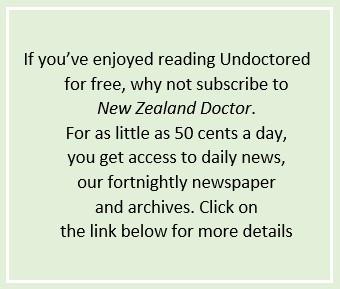Respiratory physician Lutz Beckert considers chronic obstructive pulmonary disease management, including the prevention of COPD, the importance of smoking cessation and pulmonary rehabilitation, and the lifesaving potential of addressing treatable traits. He also discusses the logic of inhaler therapy, moving from single therapy to dual and triple therapy when indicated, as well as other aspects of management
TOP will tax junk food to pay for cheaper doctors’ visits and free dental care for our poorest adults
TOP will tax junk food to pay for cheaper doctors’ visits and free dental care for our poorest adults

- Introduce a 20% tax on all junk food, including sugary drinks
- Keep doctor’s visits to less than $10
- Free dental care for adults on the lowest incomes – about one in five people
- Nationwide access to cheap, healthy fruit and veggie-box schemes
- Ban all junk food marketing to kids.
Auckland, 14 October 2020: The Opportunities Party (TOP) will use a 20 percent tax on all junk food – including sugary drinks – to help fund a range of public health measures such as cheaper doctor’s visits and free dental care for low-income adults.
The goal of the policy would be to keep the cost of doctor’s visits to less than $10. It would also mean that approximately one in five New Zealand adults would be eligible for free dental care.
TOP will also use the money raised from the tax – an estimated $1b – to ensure that everyone gets access to affordable, healthy fruit and vegetables through local veggie box schemes.
South Auckland-based GP and TOP Board Member Dr Jono Hoogerbrug says that unhealthy food is a major public health issue and finding ways of encouraging people to eat healthier will have major long-term benefits.
“Eating healthy food can lower your risk of heart disease, stroke and some cancers and it can also help you to have a healthy bodyweight,” he says. “Even our most vulnerable children are asking the government to take a stand on unhealthy food to help support them and their families. As a doctor in Papatoetoe, I see first-hand the consequences of Auckland being saturated in junk food outlets.”
New Zealand ranked second worst in the OECD for childhood obesity, with 39 percent of Kiwi kids classified as overweight or obese according to a report published by UNICEF late last year. Dr Hoogerbrug says as part of TOP’s commitment to healthy eating it would also ban all junk food marketing to children.
Dr Hoogerbrug says that TOP would use the existing healthy star labelling system to decide what foods should be taxed. The tax would include not just sugary drinks but foods such as sweets, biscuits, and salty snacks such as potato chips. A similar scheme was introduced in Mexico in 2013. Since then junk food consumption in Mexico has dropped by at least 7 percent.
“Mexico has done it successfully, so we know it’s possible. Research in Mexico shows that those who eat the most junk food are the most likely to change their behaviour as a result of the tax.”
Sugar taxes in some form have been implemented in over 40 countries and are backed by WHO, World Cancer Research Fund, NZ Heart Foundation, Royal Australian College of Physicians, Royal New Zealand College of GPs as an effective tool in reducing rates of obesity.
Dr Hoogerbrug says the money raised from the junk food tax would make it possible to implement two important public-health measures: cheaper doctors’ visits and free dental care for those on the lowest incomes.
The goal of the policy would be to keep the cost of doctor’s visits under $10. This would help ensure that at-risk populations have access to preventative care. TOP would also use the tax to provide free dental care for those on very low incomes – about 20 percent of the adult population.
TOP Deputy Leader and former Crown Prosecutor Shai Navot says that ensuring dental care is affordable will also improve long-term health outcomes for low-income Kiwis.
“We know that at present many New Zealanders can’t afford to go to the dentist, which means that many are in a lot of pain and discomfort. Poor oral health can also cause other health problems, such as an increased risk of developing heart and respiratory disease.”
Navot says setting up fruit and veggie box schemes around the country to provide easy access to affordable, healthy produce is a no-brainer. “These schemes are relatively easy to set up and run, and they make it easier for everyone to have access to healthy food choices.”
Click here to subscribe





![Barbara Fountain, editor of New Zealand Doctor Rata Aotearoa, and Paul Hutchison, GP and senior medical clinician at Tāmaki Health [Image: Simon Maude]](/sites/default/files/styles/thumbnail_cropped_100/public/2025-03/Barbara%20Fountain%2C%20editor%20of%20New%20Zealand%20Doctor%20Rata%20Aotearoa%2C%20and%20Paul%20Hutchison%2C%20GP%20and%20senior%20medical%20clinician%20at%20T%C4%81maki%20Health%20CR%20Simon%20Maude.jpg?itok=-HbQ1EYA)
![Lori Peters, NP and advanced health improvement practitioner at Mahitahi Hauora, and Jasper Nacilla, NP at The Terrace Medical Centre in Wellington [Image: Simon Maude]](/sites/default/files/styles/thumbnail_cropped_100/public/2025-03/2.%20Lori%20Peters%2C%20NP%20and%20advanced%20HIP%20at%20Mahitahi%20Hauora%2C%20and%20Jasper%20Nacilla%2C%20NP%20at%20The%20Terrace%20Medical%20Centre%20in%20Wellington%20CR%20Simon%20Maude.jpg?itok=sUfbsSF1)
![Ministry of Social Development health and disability coordinator Liz Williams, regional health advisors Mary Mojel and Larah Takarangi, and health and disability coordinators Rebecca Staunton and Myint Than Htut [Image: Simon Maude]](/sites/default/files/styles/thumbnail_cropped_100/public/2025-03/3.%20Ministry%20of%20Social%20Development%27s%20Liz%20Williams%2C%20Mary%20Mojel%2C%20Larah%20Takarangi%2C%20Rebecca%20Staunton%20and%20Myint%20Than%20Htut%20CR%20Simon%20Maude.jpg?itok=9ceOujzC)
![Locum GP Helen Fisher, with Te Kuiti Medical Centre NP Bridget Woodney [Image: Simon Maude]](/sites/default/files/styles/thumbnail_cropped_100/public/2025-03/4.%20Locum%20GP%20Helen%20Fisher%2C%20with%20Te%20Kuiti%20Medical%20Centre%20NP%20Bridget%20Woodney%20CR%20Simon%20Maude.jpg?itok=TJeODetm)
![Ruby Faulkner, GPEP2, with David Small, GPEP3 from The Doctors Greenmeadows in Napier [Image: Simon Maude]](/sites/default/files/styles/thumbnail_cropped_100/public/2025-03/5.%20Ruby%20Faulkner%2C%20GPEP2%2C%20with%20David%20Small%2C%20GPEP3%20from%20The%20Doctors%20Greenmeadows%20in%20Napier%20CR%20Simon%20Maude.jpg?itok=B0u4wsIs)
![Rochelle Langton and Libby Thomas, marketing advisors at the Medical Protection Society [Image: Simon Maude]](/sites/default/files/styles/thumbnail_cropped_100/public/2025-03/6.%20Rochelle%20Langton%20and%20Libby%20Thomas%2C%20marketing%20advisors%20at%20the%20Medical%20Protection%20Society%20CR%20Simon%20Maude.jpg?itok=r52_Cf74)
![Specialist GP Lucy Gibberd, medical advisor at MPS, and Zara Bolam, urgent-care specialist at The Nest Health Centre in Inglewood [Image: Simon Maude]](/sites/default/files/styles/thumbnail_cropped_100/public/2025-03/7.%20Specialist%20GP%20Lucy%20Gibberd%2C%20medical%20advisor%20at%20MPS%2C%20and%20Zara%20Bolam%2C%20urgent-care%20specialist%20at%20The%20Nest%20Health%20Centre%20in%20Inglewood%20CR%20Simon%20Maude.jpg?itok=z8eVoBU3)
![Olivia Blackmore and Trudee Sharp, NPs at Gore Health Centre, and Gaylene Hastie, NP at Queenstown Medical Centre [Image: Simon Maude]](/sites/default/files/styles/thumbnail_cropped_100/public/2025-03/8.%20Olivia%20Blackmore%20and%20Trudee%20Sharp%2C%20NPs%20at%20Gore%20Health%20Centre%2C%20and%20Gaylene%20Hastie%2C%20NP%20at%20Queenstown%20Medical%20Centre%20CR%20Simon%20Maude.jpg?itok=Z6u9d0XH)
![Mary Toloa, specialist GP at Porirua and Union Community Health Service in Wellington, Mara Coler, clinical pharmacist at Tū Ora Compass Health, and Bhavna Mistry, specialist GP at Porirua and Union Community Health Service [Image: Simon Maude]](/sites/default/files/styles/thumbnail_cropped_100/public/2025-03/9.%20Mary%20Toloa%2C%20Porirua%20and%20Union%20Community%20Health%20Service%20in%20Wellington%2C%20Mara%20Coler%2C%20T%C5%AB%20Ora%20Compass%20Health%2C%20and%20Bhavna%20Mistry%2C%20PUCHS%20CR%20Simon%20Maude.jpg?itok=kpChr0cc)